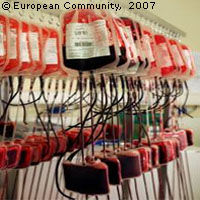New intelligence system to identify public health threats
Scientists at the European Commission's Joint Research Centre (JRC) have developed a medical intelligence system that continuously collects and sorts information from more than 1,000 news and 120 public health websites in 32 languages. The system, known as MediSys, will provide health authorities with real-time information on disease outbreaks and industrial accidents, allowing them to react in an appropriate and timely way. On 16 August, the issues creating the highest number of articles were a cholera outbreak in Sudan that had claimed the lives of 49 people, and the spread of blue-ear pig disease in China. An overview of the last 24 hours also indicates that 71 articles have reported the lifting of the UK 'control zones' that were put in place after foot and mouth was detected in cattle, while 10 articles have covered a scientific study showing how the AIDS virus attacks the brain. A table also lists recent disease incidents, from the cholera outbreak in Sudan to Avian Influenza in Vietnam and Legionellosis in Spain. Traditional surveillance systems monitor death rates, how health services are used (emergency admissions, prescriptions), abnormal patterns, changing laboratory characteristics and exposure to environment-, food- or animal-related risks. However, some threats that could otherwise go unnoticed are reported by the local press or other less known sources. The challenge, until now, has been to find these sources. Using pre-defined keywords and combinations, MediSys trawls the web and sorts information into three primary categories: 'diseases', 'bioterrorism' and 'other threats'. Articles or alerts are then classified into more precise categories, such as 'HIV-AIDS', 'respiratory infections', 'nuclear safety' etc. When a predetermined level of new articles is reached, an automatic alert can be sent by e-mail and text message to decision-makers. This happened recently when a sudden jump in news reports on foot and mouth was detected in the UK. Alerts were sent to public health officials across Europe.



